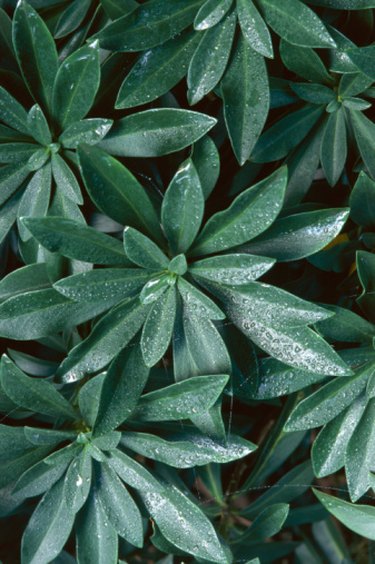Things You'll Need
Potting soil
Sand
Perlite
Shallow clay dish
Small gravel or decorative rock
Moisture meter

The African milk tree is a Euphorbia and thrives in conditions traditional for most cacti. It is sometimes called the cathedral tree because the stems rise up from the base like the turrets and spires on a grand old church. African milk tree has all the best characteristics of a succulent and cactus. It does have a potentially toxic sap so care must be taken to wear gloves and keep from rubbing your eyes. The plant is most often grown indoors because of the necessity of very warm temperatures and frost tender status. Euphorbias are easy to grow with the exception of irrigation, which is hard to manage.
Step 1
Plant the African milk tree in a rich, well-drained soil. The biggest problem with this Euphorbia is overwatering. Make your own blend of two parts potting soil, one part sand and one part perlite. This will have sufficient drainage and nutrients. Fill the pot two-thirds of the way with this mixture.
Video of the Day
Step 2
Settle the Euphorbia into the soil until its roots are just covered and fill the rest of the way with your potting medium. Don't allow soil to pile up on the stem of the plant. This will reduce circulation and may cause rotting on the stem. Spread a light mulch of tiny gravel or decorative rock over the top of the soil.
Step 3
Water the African milk tree at planting but not again until the soil is completely dry. On average, the plant will need water every two weeks in the warm growing season and every month in the winter. However, adequate moisture must be provided even though this is a drought-tolerant plant. A moisture meter will help you decide when to water.
Step 4
Push the sensor end or stem of the meter into the soil as far as it will go. Watch the gauge to see what level it detects. If it is dry at the bottom of the pot, pull the stem up half way and test the middle of the soil. If it still registers "dry" on the meter it is time to water. Touching the surface of the soil is not a good way to determine watering needs. The top of the soil will dry out fastest because of its exposure to air but the roots are farther down and this is where it is most important to provide moisture.
Step 5
Watch for insect pests. The poisonous sap will repel most sucking insects but soil gnats are prevalent, especially if the soil is kept too moist. Their presence is a good indicator that you need to suspend irrigation.
Step 6
Keep the plant in a sunny window but keep an eye out for color changes on the skin. This could indicate sunburn. Move the plant to a less bright location during the midday sun. African milk tree needs to be grown where temperatures are no lower than 50 degrees Fahrenheit. You can grow it outside in summer, but make sure you bring it into the warmth when temperatures begin to drop.
Video of the Day